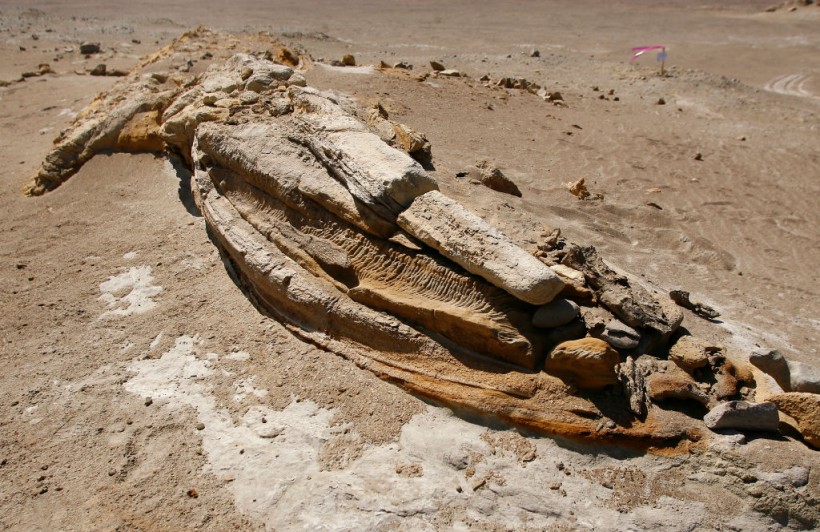An ancient colossal whale species, Perucetus colossus, that lived 39 million years ago has surpassed the weight of blue whales. The newly described basilosaurid was estimated to weigh between 187,000 to 750,000 pounds and measured approximately 66 feet in length.

The fossilized jaw of a whale lies on the desert pavement of Ocucaje, 310 km south of Lima on July 4, 2012.
Monstrous Ancient Marine Mammal
The study, titled "Could This Ancient Whale Be the Heaviest Animal Ever?" published in the journal Nature, revealed that paleontologists stumbled upon the partial skeletal remains of the massive marine mammal in what is now Ica Province, Peru, about 30 years ago. Over time, they unearthed 13 vertebrae, four ribs, and a hip bone, revealing its colossal size.
Due to the limited number of bones and the decay of soft tissues over the years, researchers estimated the whale's weight using the recovered dense bones.
Lead author Eli Amson, a paleontologist and curator of fossil mammals at the Stuttgart State Museum of Natural History, described to Live Science the challenging excavation process, with each vertebra alone weighing a staggering 150 kilograms (330 pounds).
Based on the density of the bones, the team hypothesized that P. colossus likely had lighter soft tissues, compensating for the weight of its skeleton and making it more buoyant.
As the whale's soft tissues have completely decayed, its appearance remains uncertain. However, the researchers compared it to a modern manatee, but with an odd combination of a large body, tiny head, and small arms and legs.
Despite being bulkier than a blue whale in terms of weight, P. colossus had a shorter overall body length, measuring 20 meters (66 feet). The team approached size estimates conservatively, given the challenge of accurately determining the amount of blubber and soft tissues surrounding the skeleton.
Researchers suggested that the peculiar appearance of P. colossus might have contributed to its buoyancy and allowed it to move slowly through water, akin to how manatees glide.
READ ALSO: 60-Feet Monstrous Overlords Terrorized Creatures in Ancient Seas
Life of a Giant Whale
The study indicates that gigantism in cetaceans, reaching peak body mass, occurred about 30 million years earlier than previously believed.
As per CNN's report, the heavy bone structure of P. colossus suggests the presence of lighter tissues, providing neutral buoyancy in water, unlike land-dwelling animals where all tissues contribute to weight support. The fossil indicates that the whale reached sexual maturity but might still have been growing due to the unfused ends of its vertebrae.
Perucetus likely had an unusual feeding behavior, feeding near the sea bottom, and not being an active predator, in contrast to most whales that chase fast-moving prey with their lighter skeletons.
The researchers hypothesize three possible diets for Perucetus; it might have been a herbivorous plant eater like a sea cow, which would be unique among cetaceans, or it could have fed on small mollusks and crustaceans in sandy bottoms, similar to the contemporary gray whale, or possibly scavenged vertebrate carcasses.
The discovery of Perucetus colossus has far-reaching implications beyond documenting a new life form. It could provide insights into the origin of blubber, potentially advantageous around 39 million years ago when Earth and the oceans were cooling.
The researchers aim to continue exploring the Ica desert to uncover more fossils, further enriching our understanding of the extraordinary evolutionary history of cetaceans.
RELATED ARTICLE: How a Beaked Whale Fossil May Reveal Origins of Humanities First Steps
Check out more news and information on Paleontology in Science Times.














